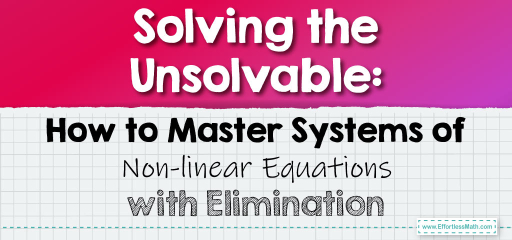Solving the Unsolvable: How to Master Systems of Non-linear Equations with Elimination
Solving systems of non-linear equations by elimination involves combining the equations in such a way as to eliminate one of the variables, allowing you to solve for the others. This method works well when you can easily manipulate the equations to cancel out one variable. Here's a step-by-step guide:

A Step-by-Step Guide to How to Master Systems of Non-linear Equations with Elimination
Step 1: Understand Your Equations
- Start by reviewing your system of non-linear equations. Note the variables and their coefficients. The equations might involve squares, cubes, or other non-linear terms.
Step 2: Prepare the Equations
- Arrange the equations so that like terms are aligned with each other. This might involve rewriting equations to place them in a standard form where corresponding variables and their coefficients align vertically.
Step 3: Adjust Coefficients for Elimination
- Look for a way to multiply each equation by a number that will make the coefficients of one of the variables the same (or exact opposites) in both equations. This is done so that when the equations are added or subtracted, one of the variables will be eliminated.
Step 4: Eliminate a Variable
- Add or subtract the equations from each other to eliminate one variable. This will leave you with a single equation in one variable (which might still be non-linear).
Step 5: Solve the Resulting Single-variable Equation
- Solve the equation from Step 4 for the remaining variable. Since this is a non-linear system, be prepared to solve quadratic equations, cubic equations, etc., which may have more than one solution.
Step 6: Back-Substitute to Solve for Other Variable(s)
- Take the solution(s) found in Step 5 and substitute it back into one of the original equations to solve for another variable. This might involve further solving of non-linear equations.
Step 7: Check Your Solutions
- Substitute the values found back into the original equations to verify they satisfy the system. Given the possibility of making algebraic manipulation errors, this step is crucial.
Step 8: Consider All Possible Solutions
- Non-linear systems can have multiple sets of solutions, a single solution, or no solution at all. Ensure you’ve explored all possibilities, especially when solving equations that can have more than one solution.
Tips for Success
- Precision in algebraic manipulation is key to successfully applying the elimination method.
- Be thorough in considering all potential solutions, particularly when dealing with non-linear equations that may yield multiple valid answers.
- Practice with different types of non-linear systems to become familiar with the variety of strategies needed for effective elimination.
This method requires careful algebraic work and strategic thinking, especially when dealing with complex non-linear systems.
Related to This Article
More math articles
- How to Perform Operations of Decimals: Word Problems
- Algebra Puzzle – Challenge 32
- How to Balance the Scales: Inequalities with Addition and Subtraction of Mixed Numbers
- FREE 3rd Grade MCAS Math Practice Test
- 3rd Grade MAAP Math Worksheets: FREE & Printable
- Top 10 6th Grade ACT Aspire Math Practice Questions
- Do You Have to Pass the STAAR Test?
- Bridging the Gap: From Basic Math to Algebra with “Pre-Algebra for Beginners”
- FREE 8th Grade STAAR Math Practice Test
- Hоw to Gеt a Great Sсоrе оn thе SAT Math Test





















What people say about "Solving the Unsolvable: How to Master Systems of Non-linear Equations with Elimination - Effortless Math: We Help Students Learn to LOVE Mathematics"?
No one replied yet.